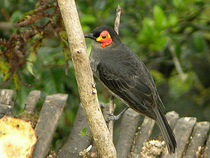Smoky Honeyeater
The species is endemic to the island of New Guinea, where it occurs in the Central Ranges across the length of the island as well as two isolated populations on north west and north of the island. There are three subspecies; the nominate race occurs in the East Herzog Mountains and south east New Guinea, M. f. kumawa is restricted to the southern Bomberai Peninsula and M. f. goliathi ranges from the Weyland Mountains to the west Herzog mountains.
The Smoky Honeyeater is classified as Least Concern. Does not qualify for a more at risk category. Widespread and abundant taxa are included in this category.
Smoky HoneyeaterPicture(s): Bruce Beehler/Conservation International | Smoky HoneyeaterThis is a new species of Smoky honeyeater discovered on the expedition. Scientists also discovered dozens of new species of frogs, butterflies and plants in the Indonesian jungle. previous1 . 2 . 3 . 4 . 5 . 6 . 7 . 8 . 9 . 10 . 11 . More
Smoky Honeyeater, Common Smoky-Honeyeater, Eastern Melipotes, Eastern Smoky-Honeyeater, Smoky Honeyeater Spanish: Mielero Ahumado, Pájaro Azúcar Común Finnish: Kaljunaamamesikko French: Méliphage à poitrine cendrée, Méliphage enfumé Indonesian: Burung madu, Melipotes Pipi-kuning Italian: Succhiamiele affumicato, Succiamiele grigiofumo Japanese: kihoomitsusui Japanese: キホオミツスイ Latin: Melipotes fumigatus Dutch: Geelwanghoningeter, Geelwang-honingeter Polish: dziwoliczek zmienny, Dziwook zmienny Slovak: medárik dymový, Medárik popolavoprsý Tai: Menna Avibase has More
MoreAug 19, 2009, 3:34pm The Wattled Smoky HoneyeaterTHE WATTLED SMOKY HONEY EATER PRESENTS: SUPER MASSIVE FUN TIME HOOTENANNY EXPLOSION WITH ROBOTS*! (image via ffffound ) Summer is almost at an end, for most university students in and around New York City. For some of us, classes begin on the last day of August, an abrupt end to a summer that was, weather-wise, too short. This is an invitation for YOU to come CELEBRATE the END OF SUMMER with US! We will be on the roof of 100 S. 4th Street (The Rocket Factory) in Brooklyn, NY beginning at 4:00 PM. More
The Smoky Honeyeater (Melipotes fumigatus) is a species of bird in the honeyeater family Meliphagidae. It is one of four species in the genus Melipotes, all closely related and forming a superspecies. After another similar species, the Wattled Smoky Honeyeater, was discovered in 2005 in the Foja Mountains it has also been called the Common Smoky Honeyeater. More
The Wattled Smoky Honeyeater (Melipotes carolae) is a species of honeyeater with a sooty-grey plumage and a black bill. The most distinctive feature is arguably the extensive reddish-orange facial skin and pendulous wattle. In other members of the genus Melipotes, these sections only appear reddish when "flushed" and the wattle is smaller. An Indonesian endemic, this honeyeater was discovered in December 2005. It is found in remote montane forests of Foja Mountains range, Western New Guinea at an altitude over 1,150 metres. More
The Wattled Smoky Honeyeater (Melipotes carolae), described in 2007, has been discovered in December 2005 in the Foja Mountains of Papua, Indonesia. In 2008, a study that included molecular phylogenetic analysis of museum specimens in the genera Moho and Chaetoptila, both extinct genera endemic to the Hawaiian islands, argued that these five species were not members of the Meliphagidae and instead belong to their own distinct family, the Mohoidae. More
The Wattled Smoky Honeyeater (Melipotes carolae) is an Indonesian endemic, that was discovered in December 2005. It was found in remote montane forests of Foja Mountains range, Western New Guinea at an altitude over 1,150 metres. The first bird species found in New Guinea since 1939, the honeyeater was one of over twenty new species discovered by an international team of eleven scientists from Australia, Indonesia and the United States, led by an American ornithologist and Melanesia Conservation International vice-president Bruce Beehler. More
For the purposes of our bird news services, Smoky Honeyeater is classed as Ungraded: species which are unlikely to appear as wild birds in Britain or Ireland hide section Most recent photos of Smoky Honeyeater (2) Kumul Lodge, Hagen, Papua New Guinea Kumul Lodge, Hagen, Papua New Guinea05/10/2006 Kumul Lodge, Hagen, Papua New Guinea 05/10/2006 Kumul Lodge, Hagen, Papua New Guinea Kumul Lodge, Hagen, Papua New Guinea05/10/2006 Kumul Lodge, Hagen, Papua New Guinea 05/10/2006 More
Wattled smoky honeyeater is a common and unwary inhabitant of the Foja uplands, and feeds mainly on small fruit. Scientific Name Melipotes carolae Where Foja Mountains in Western New Guinea. When Discovered during Conservation International’s RAP expedition to the Foja Mountains in 2005. More
Results for: smoky honeyeaterTranslations 1 - 30 of 146 English English Finnish Finnish smoky honeyeater kaljunaamamesikko, Melipotes fumigatus smoky savuinen, käryinen get smoky savuttua become smoky savuttua smoky warbler nokiuunilintu, Phylloscopus fuligiventer smoky robin savupensassieppo, Peneothello cryptoleuca smoky smell käry More
The smoky honeyeater is a species of bird that is seen in many areas of the world with new species being discovered all the time. In fact a new species of the honeyeater was discovered as recently as 2005 in the Foja Mountains. The bird is not protected as it is rated as a species of least concern, meaning it is not endangered or available only in very limited or declining numbers. More

Original source: David Ringer
Author: David Ringer
Permission: Some rights reserved
Family : Meliphagidae
Genus : Melipotes
Species : fumigatus
Authority : Meyer, 1886
